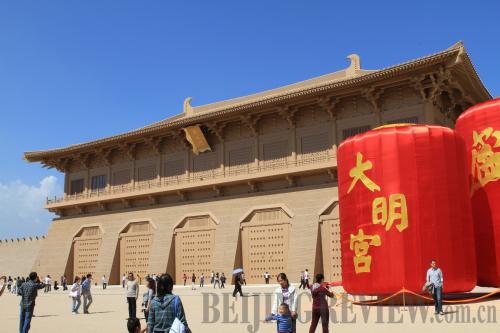|
 |
|
BRAND NEW LOOK: Tourists walk in the square of the Daming Palace National Heritage Park in Xi'an, capital city of Shaanxi Province, on October 1, 2010, when the park was opened to the public (CFP) |
On these thriving spring days, China's heritage site protection is also embracing a new spring. This golden period began last October, when the State Administration of Cultural Heritage unveiled a list of the first 12 national heritage parks for construction. Once completed, these parks will serve as public cultural spaces, offering functions including education, scientific research, tourism and recreation.
This is regarded as a new way of thinking successfully striking a balance between historical relic protection and city construction.
A hard work
Each heritage site is a mark left from an important period of Chinese history. After hundreds of years, these sites should have been precious wealth cherished by descendents. Many such sites have been damaged or even destroyed.
Located downtown or in suburbs, the heritage sites occupy a great land area. With the rapid process of urbanization, demand on land resources is surging. As a result, the conflict between heritage site protection and city development has become extremely tense. And protection work faces unprecedented challenges.
It is often a case that the areas where heritage sites are located had always been neglected. They are generally dirty and disorderly with poor public security, even becoming areas with the lowest living standards in the city. It became more difficult to find government departments willing to take responsibility for the sites.
Against this backdrop, how to solve the conflict between heritage site protection and city construction is an urgent issue.
Take the Daming Palace in Xi'an, capital city of northwest China's Shaanxi Province, for example. Built in 634, during the peak of the Tang Dynasty (618-907), it boasted the most representative buildings of the time. It was the political and cultural center throughout the dynasty. But, as more than 1,300 years passed, this once magnificent palace was reduced to ruins.
Despite this, the remains of the Daming Palace, covering an area of 3.2 square km, remain the most intact Tang Dynasty complex in China. They bear great significance for historical and cultural research.
The reality was depressing. In the process of urbanization, hundreds of thousands of farmers poured into the Daobei District, where the palace is located, to work and live. The district gradually became a special community of migrant workers, or a "village within city," known for its squalid living environment in the early 2000s.
The government department of cultural heritage often told the residents living in the Daming Palace heritage site not to plant vegetables or build, saying it would damage the site. But the residents complained the restrictions were making their lives inconvenient.
To be specific, it became a shantytown with a population of nearly 100,000. With a growing population and poorly managed environment, the area was considered as the shame of Xi'an.
During the deadlock, the site couldn't be protected and the residents' lives couldn't be improved, said Wu Chun, an official from the Daming Palace Heritage Site Preservation and Reconstruction Office.
This situation began to change in 2007. With the support of the State Administration of Cultural Heritage, the Xi'an Municipal Government carried out a large-scale renovation program of the site. It moved the residents and businesses out and pulled down houses they had built on the site. These measures brought win-win results for both the Daming Palace heritage site and the residents. As they combined protecting the heritage site and improving the residents' living standards, it was an amiable solution.
| 